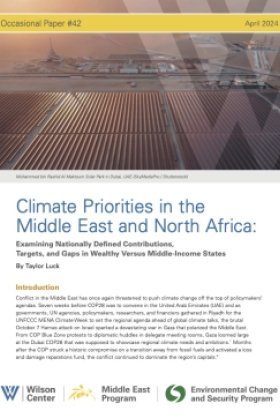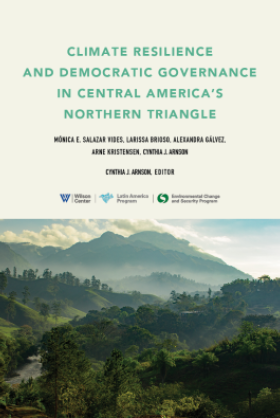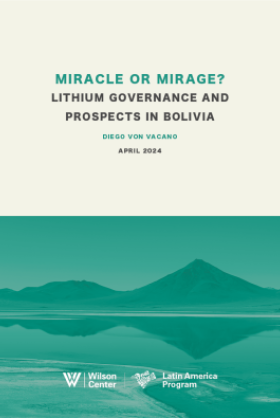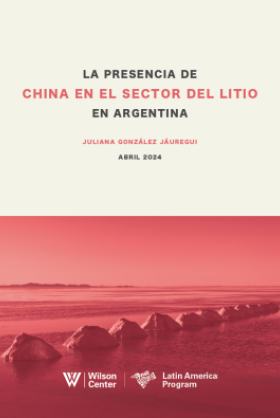Discussion: The Shape of Things to Come
Elizabeth Leahy presents the main findings of the new PAI report—which examines age structure and its bearing on political stability, democratic governance, and economic development.
Overview
"Above all, demography is not destiny. Much more than absolute numbers, what matter most are government capacity and the political commitment to carry out effective policies," said Elizabeth Leahy, lead author of The Shape of Things to Come: Why Age Structure Matters to a Safer, More Equitable World, a new publication from Population Action International (PAI). Leahy presented the main findings of the report—which examines age structure and its bearing on political stability, democratic governance, and economic development—at an event sponsored by the Environmental Change and Security Program on October 2, 2007.
Age Structure and Security
The Shape of Things to Come determines countries' age structure type—very young, youthful, transitional, or mature—by comparing the proportion of a country's population that is younger than 30 to the proportion that is older than 60. More countries have very young age structures—in which more than two-thirds of the population is under 30, and fertility rates and mortality rates are very high—than any other age structure. In countries with youthful age structures, the proportion of the total population under 30 years old is between 60 and 67 percent. In countries with transitional age structures, this proportion is between 45 and 60 percent; in countries with mature age structures, it is less than 45 percent.
The authors of The Shape of Things to Come conclude that the influence of age structure on a country's economic growth, risk of an outbreak of conflict, and progress toward democracy is both significant and quantifiable. Leahy stressed two of the report's key findings on age structure: that it matters to development, and that it is not immutable. "Age structure is not a given. More balanced age structures can be—and have been—promoted by policies that address demographics, particularly family planning and reproductive health," she said. Leahy cited Mexico and Tunisia as examples of countries that have successfully transitioned from very young to transitional age structures, due to strong commitments from their governments to rights-based, comprehensive family planning programs, as well as other initiatives.
Age structure has serious implications for a country's prospects for stability. According to the report, between 1970 and 1999, 80 percent of the civil conflicts that caused at least 25 deaths occurred in countries with youthful or very young age structures. Moreover, during the same period, nearly 90 percent of countries with very young age structures had autocratic or weakly democratic governments. Conversely, more than 80 percent of countries with mature age structures were fully democratic. The authors of The Shape of Things to Come also examined the relationship between age structure and failed states, using Foreign Policy magazine's 2007 Failed States Index. They found that the index ranked 51 percent of countries with very young age structures as "critical" or "in danger," and ranked none of them as "stable" or "most stable." Moreover, every country the index ranked as "most stable" had a mature age structure.
The Right Investments
Leahy emphasized that age structures are dynamic and can be influenced by programs aimed at youth. "In order for young people to be productive and invested in society, they must have access to education, health care, and employment," Leahy said. "The problem is not that there are too many young people, but that there are too few opportunities and resources available to them." She continued, "Young people are the most important asset a society has in looking to the future. When young people are educated, healthy, and employed, they are the ones who renew and revitalize a country's economy and institutions….Age structure, at its heart, underlines the importance of investing in youth."
Countries that make progress along the demographic transition—the path from high birth and high death rates to low birth and low death rates—are rewarded with a one-time opportunity: the "demographic dividend." The first generation with declining fertility has fewer children to support, and therefore greater economic opportunities from increased savings. Yet this generation of smaller families is itself large, so the country's economy typically continues to grow, buoyed by a substantial working population. The "window of opportunity" to take advantage of the demographic dividend lasts only 40 to 60 years, however, and the benefits associated with the demographic dividend are "not automatic," Leahy warned. "Governments must make the right investments. If they do, the demographic dividend can lead to higher wages, higher levels of investment, and a more productive and technically advanced workforce. For example, this is what we saw in the Asian Tiger countries in the 1970s and ‘80s, who were able to take advantage of their demographic dividend with the right policies and investments, and, partially as a result, see strong economic growth."
The authors of The Shape of Things to Come recommend that governments and international organizations support programs—such as comprehensive family planning and reproductive health programs—that promote more balanced age structures. In addition, governments should invest in girls' education and offer women the same level of legal protection as men. These interventions all promote more balanced age structures—which make countries less vulnerable to conflict and poverty.
A Tool for Policymakers
 U.S. Representative Russ Carnahan (D-MO), who serves on the House Foreign Affairs Committee, praised The Shape of Things to Come as a valuable tool for policymakers. "It really looks at our policy in a broader context. It looks at trends and quantifies them in a way that really arms policymakers and gets us beyond some of these ideological barriers that have stopped us from looking at the bigger picture," said Carnahan. He continued, "[It] shows concrete evidence that with a change in policy, we can actually change some of those demographic trends for the better….It's a great tool for all of us that are debating public policy."
U.S. Representative Russ Carnahan (D-MO), who serves on the House Foreign Affairs Committee, praised The Shape of Things to Come as a valuable tool for policymakers. "It really looks at our policy in a broader context. It looks at trends and quantifies them in a way that really arms policymakers and gets us beyond some of these ideological barriers that have stopped us from looking at the bigger picture," said Carnahan. He continued, "[It] shows concrete evidence that with a change in policy, we can actually change some of those demographic trends for the better….It's a great tool for all of us that are debating public policy."
 Jordan Press, senior legislative assistant to U.S. Representative Christopher Shays (R-CT), stated, "Mr. Shays sees population issues as one of the most significant challenges that our world is facing. In fact, he thinks that unsustainable growth of our global population is one of the great ‘inconvenient truths' of our time." Press continued, "African nations—as well as others that are experiencing rampant population growth—are going to continue to struggle while families have seven or eight children. The fact is, one mouth can eat, two mouths can share, but four mouths go hungry, and eight mouths starve."
Jordan Press, senior legislative assistant to U.S. Representative Christopher Shays (R-CT), stated, "Mr. Shays sees population issues as one of the most significant challenges that our world is facing. In fact, he thinks that unsustainable growth of our global population is one of the great ‘inconvenient truths' of our time." Press continued, "African nations—as well as others that are experiencing rampant population growth—are going to continue to struggle while families have seven or eight children. The fact is, one mouth can eat, two mouths can share, but four mouths go hungry, and eight mouths starve."
Directions for Future Research
 Henry L. Stimson Center President and CEO Ellen Laipson spoke to the report's implications for the security community and highlighted several promising areas for further research on the links between age structure and civil conflict. For instance, she asked how much of the effort to achieve more balanced age structures will come from governments and how much from nongovernmental organizations and civil society groups. In a world that will continue to become increasingly globalized, Laipson predicted, nongovernmental actors will assume greater importance than ever before. In addition, she wanted to know whether a country's transition to a more balanced age structure can help bolster the popularity or legitimacy of its government. She also urged the report's authors to consider how migration and refugees change age structure and affect the likelihood of conflict.
Henry L. Stimson Center President and CEO Ellen Laipson spoke to the report's implications for the security community and highlighted several promising areas for further research on the links between age structure and civil conflict. For instance, she asked how much of the effort to achieve more balanced age structures will come from governments and how much from nongovernmental organizations and civil society groups. In a world that will continue to become increasingly globalized, Laipson predicted, nongovernmental actors will assume greater importance than ever before. In addition, she wanted to know whether a country's transition to a more balanced age structure can help bolster the popularity or legitimacy of its government. She also urged the report's authors to consider how migration and refugees change age structure and affect the likelihood of conflict.
 Laipson reminded the audience that although demography is a powerful variable in the conflict equation, "we must be careful to not overstate its predictive value. It is a way of understanding what contributes to change, but it will not always be the determinative factor." However, as William Butz, president and CEO of the Population Reference Bureau, argued, "This report places the burden of doubt—the burden of proof—on analysts, researchers who think that it is something else other than age structure that's going on here, causally."
Laipson reminded the audience that although demography is a powerful variable in the conflict equation, "we must be careful to not overstate its predictive value. It is a way of understanding what contributes to change, but it will not always be the determinative factor." However, as William Butz, president and CEO of the Population Reference Bureau, argued, "This report places the burden of doubt—the burden of proof—on analysts, researchers who think that it is something else other than age structure that's going on here, causally."
 Amy Coen, PAI's president and CEO, urged the audience to use The Shape of Things to Come as a practical tool for helping formulate policies that promote stability and prosperity around the world. "We hope that you'll be able to look at a country's age structure and know some critical things about what that country needs: the types of programs and investments that will make that country healthier, more peaceful, more democratic," she said. "It is not wonky to say that demographics is fundamental to development—it's right."
Amy Coen, PAI's president and CEO, urged the audience to use The Shape of Things to Come as a practical tool for helping formulate policies that promote stability and prosperity around the world. "We hope that you'll be able to look at a country's age structure and know some critical things about what that country needs: the types of programs and investments that will make that country healthier, more peaceful, more democratic," she said. "It is not wonky to say that demographics is fundamental to development—it's right."
Drafted by Rachel Weisshaar.
Documents & Downloads
Speakers

Elizabeth Leahy Madsen
Russ Carnahan
Jordan Press

Ellen Laipson
William Butz
Amy Coen
Hosted By

Environmental Change and Security Program
The Environmental Change and Security Program (ECSP) explores the connections between environmental change, health, and population dynamics and their links to conflict, human insecurity, and foreign policy. Read more
Thank you for your interest in this event. Please send any feedback or questions to our Events staff.









